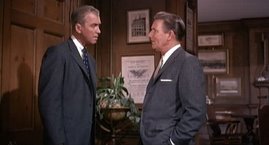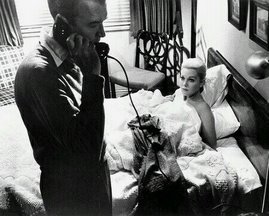Sidney Davis (born 1 April 1916 - 16 October 2006, Palm Desert, California) was a United States social guidance film director and producer. Born to a father who was a housepainter and a mother who was a dressmaker, Davis moved to Hollywood, California with his family when he was four. He began work in film as a child, getting bit parts to help his family financially. Davis went on to become a stand-in for Leif Erickson and later John Wayne.
In November 1949, Linda Joyce Glucoft, a six-year-old girl in Los Angeles, California, was molested and murdered by a man named Fred Stroble. The story was front-page news in the Los Angeles Times for a week as police and the FBI searched for Stroble. The story was picked up by Time Magazine and other national media, and led to a flurry of reported rapes and attempted rapes. Some media began to speculate that the supposed epidemic of rape was simply media manipulation of public perception.
Davis claimed that he was disturbed by the case, particularly because his daughter, Jill, then six years old, didn't seem to pay enough attention to his warnings about strangers. He approached John Wayne for a $1,000 loan and used the money to make his first film, The Dangerous Stranger, a film he would remake at least twice over the next 30 years. The film tells the story of several young children -- some of the children are kidnapped and eventually saved, others are kidnapped and never seen again.
Davis sold the film to schools and police departments and within a short time had made $250,000 from it. He used the money to make more than 150 films over the next few decades. Davis's films are typically 10 to 30 minutes long; Davis prided himself on making each one for $1,000, a minuscule sum for a film, even at that time.
His films cover topics such as driver safety, marijuana use, heroin addiction, and gang warfare, among other things. Live and Learn (1956), a fairly famous Davis film, features Davis' daughter Jill cutting out paper dolls in her room. When her father comes home Jill jumps up, trips on the carpet, and impales herself on the scissors. Other children in the film are equally unlucky -- falling off cliffs, being run over by cars, or losing vision in one eye from flying shards of glass.
One of Davis' most notorious films is Boys Beware (1961), which warns boys of the perceived dangers of male homosexuals. The film includes the line "What Jimmy didn't know was that Ralph was sick -- a sickness that was not visible like smallpox, but no less dangerous and contagious--a sickness of the mind. You see, Ralph was a homosexual: a person who demands an intimate relationship with members of their own sex." The same year, Davis made Girls Beware, warning girls not to put themselves into situations where they would be defenseless, a topic that Davis had covered at least 10 years earlier in his film Name Unknown, in which a man with a gun holds up a couple in isolated surroundings, forcing the boy into the trunk of the car and raping the girl.
Also in 1961, Davis made the film Seduction of the Innocent, targeting teenagers with the message that marijuana use leads to heroin addiction, a message that many marijuana activists dispute as an example of a slippery slope fallacy. The film follows a teenage girl through her experimentation with "reds", "pep pills", and 7-Up, to her first puff of marijuana, to experimentation with and addiction to heroin, to her fate as a prostitute arrested on her twentieth birthday, "lost to society." The film promises that "she'll continue her hopeless, degrading existence until she escapes in death."
Davis' work is consistently about a relatively small group of themes: that strangers must be treated with caution, that the world itself is an unfriendly place, regardless of the presence of strangers, and that children must think before acting. His films typically feature monotonous narration suffused with what Mental Hygiene author Ken Smith calls a "sledgehammer morality." His work, though largely anecdotal and unschooled, is notable among social guidance films because Davis covered topics that larger, more scholarly film producers such as Coronet Films and Encyclopædia Britannica wouldn't touch for years. Coronet, Centron Corporation, and Britannica typically had teams of scholars with PhDs in sociology guiding development of their films. Davis, when he used consultants, rarely used anyone with a degree in a relevant field, though he did often use policeman and detectives for their anecdotal advice.
Aside from his educational films, generally known for their bleakness and simplistic presentations, Davis made police training films such as Shotgun or Sidearm? (explaining which situations call for which firearms) and military films such as LAPES and PLADS (explaining delivery systems developed to allow planes to drop supplies onto exact locations in generally hostile territory in Vietnam).
Two atypical films in his educational film canon are Gang Boy and Age 13, filmed in 1954 and 1955, respectively. Both were written and directed by Art Swerdloff. In Gang Boy, Mexican and Anglo gangs in southern California declare a truce and begin working together to make a better world for their younger siblings. The film was based on a true story that happened in Pomona in the 1950s.
After a few years of directing films, Davis continued as a cinematographer for his company, Sid Davis Productions, hiring others such as Art Swerdloff, Robert D. Ellis, and Ib Melchior to write and direct. Later he hired cinematographers to lens the films as well as office workers to distribute them, and spent his time climbing mountains instead.
Yes its the classic BOYS BEWARE. Beware of the sick "humasex'yall"
and its companion GIRLS BEWARE. Beware of EVERYTHING!
Subscribe to:
Post Comments (Atom)








No comments:
Post a Comment